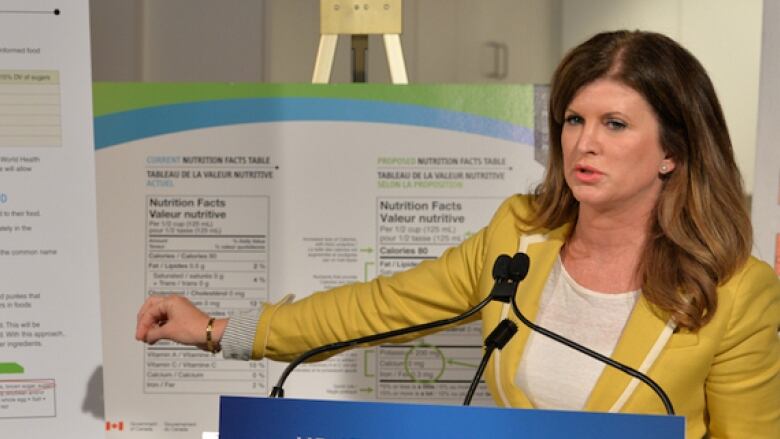Improved nutrition labels could still be 5 years away
Added-sugars information missing from latest proposed changes by Health Canada

If three-quarters of acupofReese's Puffs cereal has110 calories, onegram of dietary fibre and two grams of protein;and one cup of Kellogg's Special K cereal has 120 calories, no dietary fibre but sixgrams of protein,which one should you eat for breakfast?
The Canadian government is in the process of ending the days of trying to do quick mental math at the grocery, but that may still befive years away, if not longer.
- Nutrition labels proposal gets positive reaction
- New labels will be 'easier to read,' Health Canada proposes
Health Canadareleased itslatest proposed changes to nutritional labels onfood packageson June 12to help shoppers make sense of the not-so-intuitiveinformation boxes.
After the public consultation period, the agency has "no formal deadline" topublish final nutrition label guidelines, and it hasproposed that businesses can take up to five years to implement the changes.
These new labels aren't coming fast enough to help confused consumers make better food choices, some nutrition experts say. And, despite more than two years of prep time, the proposed revamped labels lack some key ingredients.
'A step in the right direction'
The changes are "definitely an improvement," says Abby Langer, a registered dietician and owner of Abby Langer Nutrition.
She's pleased that the new labels promote standardizingserving sizesfor similar products. Yogurts, for example, could all show nutritional information for a three-quarter-cup serving.
Food that isn't easily measuredcould be counted by thenumber ofpieces (like three cookies) or a fraction(like two slices of frozen pizza). Different brands will show information for amounts that weigh about the same.
"That's so overdue," she says.
The new labels would alsogroup allsugarstogether in the ingredient list rather than listing multiple sugars (like glucose-fructose, honey, malted barley or fancy molasses) individually.
Since ingredients are listed from those most to least present infood, this means people couldhave an easier time determining how much sugar is in a product.
These changes are "a step in the right direction," Langer says.
Proposed sugar changes hit sour note
But, she and other nutrition experts are disappointed Health Canada nixed more promising sugar reforms.
About a year ago,Ambrose released the first iteration of proposed changes. Thoseincluded treating sugar similarly to fat.

Fat is further broken up into two fats that are widely considered harmful:saturated and trans fat. The proposed nutrition labels showed the amount of added sugar in food.
At the time, nutritionists celebrated this major change.
It made sugar information "super easy to understand," wrote Sue Mah, a registered dietician and the principal of Toronto-based Nutrition Solutions, in an email. Consumers could glance and see how much added sugar they would be eating or drinking.
Now, nutritionists are left confused as to why the government scrapped that helpful line.
The grouping of sugars in the ingredient list and adding a percentage for how much of a person's daily recommended intake of sugar is in the product should be enough to help people make informed choices, wroteEric Morrissette, a Health Canada spokesman, in an email.
The public has until Aug.27 to weigh in on the latest iteration of proposals, he added. Then Health Canada will review recommendations and publish final nutrition label guidelines. The agency has "no formal deadline to advance the final amendments to the nutrition labelling regulations," a spokesperson said in a statement.
5-year implementation questioned
Once those are published, companies will have five years to start printing new labels.
They should have done more to help Canadian consumers interpret those labels.- MaryL'Abb, U of T nutritional sciences department chair and professor
That seems "inordinately long," saysMaryL'Abb, a Canadian Nutrition Society board member and University of Toronto nutritional sciences department chair andprofessor.
She recalls when Canada implemented nutritional labels in 2002, the government gave businesses only three years to comply with the regulations. Small businesses were permitted up to five years.
"The vast majority of the food industry were fully compliant within three years," she says. "Three years is absolutely doable."
Five years will give businesses, especially small ones, the time "to exhaust their current labels," saysHealth Canada spokesmanMorrissette.
Plus, this time, the Canadian Food Inspection Agency is simultaneously in the midst of modernizing food labelling regulations, he says.The longer five-year period is meant "to minimize cost" for companies that have to adjust their labelling to both Health Canada and CFIA changes.
Hopefully, many companies simply won't need the full five-year term, says Mah. She remembers many companies transitioned well before the deadline set in 2002 when labels were introduced.
Interpretation still a problem
Even once the changes finally become mainstream on supermarket shelves, they may fall short of their goal to help many Canadians make smarter food choices.
Many of the changes are technical and won't have "significant public health impact," saysL'Abb.
She agrees that standardized servingsizes and sugar groupings are positive changes, but would have liked to see Canada create a simple system to help peopleunderstand the information the nutritional box contains.
Australia, for example, puts from one-half to five stars on food packages to rate their nutritional value, she says. Companies can volunteer to participate in a five-year trial of the program that started in June 2014.
Some food packages in the United Kingdom, meanwhile, use red, amber or green traffic light colours to signify if a food has lots, some or little fat, sugar and sodium. A U.S. study suggests these types of labels help people make healthier food choices.
L'Abb would have wanted Canada to match some of these innovative practices.
"They should have done more to help Canadian consumers interpret those labels."












_(720p).jpg)


 OFFICIAL HD MUSIC VIDEO.jpg)
.jpg)



























































































